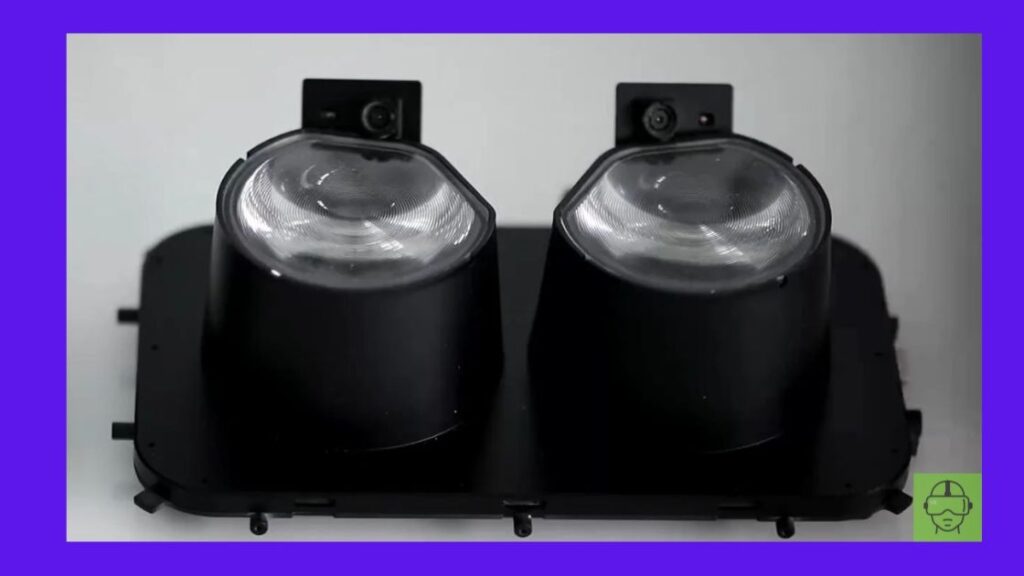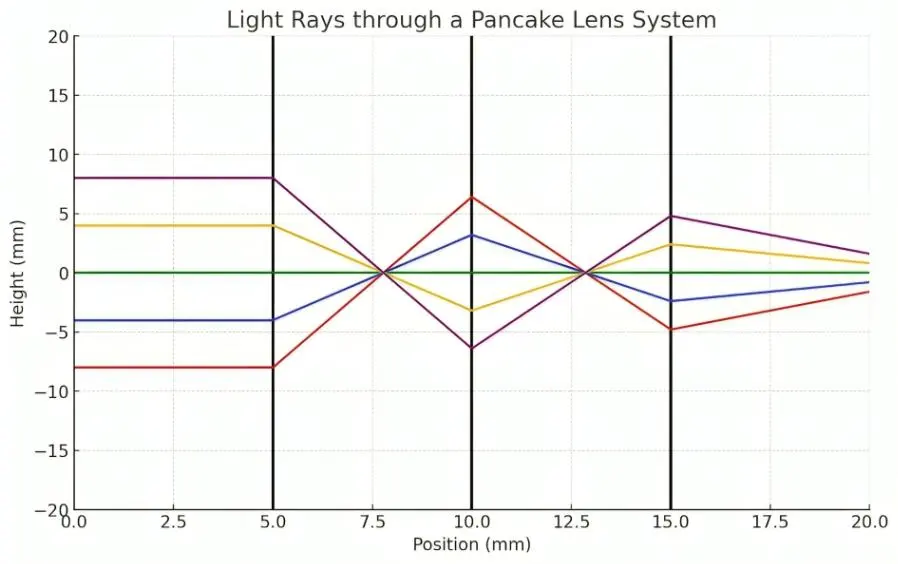
Virtual reality (VR) technology has come a long way over the past decade, bringing us closer to fully immersive digital experiences. While the software behind VR has seen significant advancements, the hardware—specifically, the lenses—has also evolved. One of the latest innovations in this space is the pancake VR lens, which promises to make headsets more compact, lightweight, and comfortable. But what exactly are pancake VR lenses, and how do they compare to traditional Fresnel lenses? Let’s explore.
Read More: Meta Quest 3 Decals: Personalize Your VR World
What are the Pancake Lenses VR?
Pancake lenses: Pancake lenses are designed to be more compact and lightweight compared to the traditional Fresnel lenses found in most VR headsets today. While Fresnel lenses work by diffracting light to create a virtual image, requiring a relatively large distance between the lens and the display, pancake lenses use a series of reflective elements to fold the light path multiple times before it reaches the user’s eye. This innovative design allows pancake lenses to be much thinner and lighter than Fresnel lenses, making VR headsets with pancake lenses more comfortable for extended use.
How do the lenses work in VR?
To understand their transformative power, let’s look into the fascinating mechanisms that bring them to life.
At their core, pancake lenses utilize well-established optical principles to focus light. One key element is internal reflection. Imagine the lens filled with meticulously shaped glass pieces. Light entering the lens bends, or refracts, thanks to this design, concentrating the light rays. But here’s the twist: some light collides with the glass surfaces and bounces back – this is internal reflection.

By meticulously crafting the shape and angles of these glass elements, engineers orchestrate how light bounces within the lens. This intricate dance ensures all light rays converge precisely, resulting in a crisp, clear image. This clever combination of precisely arranged glass elements and controlled internal reflection allows pancake lenses to achieve a remarkably thin profile. They optimize functionality without sacrificing optical quality, paving the way for a sleeker, more comfortable VR experience. (Pancake Lenses VR)
The Advantages of Pancake VR Lenses
More Compact and Lightweight
One of the most significant benefits of pancake VR lenses is their compact and lightweight design. By folding the light path, these lenses can drastically reduce the size and weight of VR headsets. This advancement makes headsets more comfortable to wear for extended periods, which is a game-changer for both casual users and hardcore gamers.
Wider Field of View
Another advantage of pancake lenses is their potential to offer a wider field of view. The thinner profile allows for more flexibility in lens placement, which can enhance the immersive experience by providing a broader visual field.
Reduced Eye Strain
Many users report experiencing less eye strain with pancake lenses compared to Fresnel lenses. This can be particularly beneficial for users who spend long hours in virtual environments, whether for gaming, work, or other activities.
The Drawbacks of Pancake VR Lenses
Higher Cost
One of the main disadvantages of pancake VR lenses is their higher manufacturing cost. This increased expense can make VR headsets with pancake lenses more expensive, potentially limiting their accessibility to a broader audience.
Lower Light Transmittance
Because pancake lenses reflect light back and forth multiple times, some light is inevitably lost in the process. This can result in a slightly dimmer image compared to Fresnel lenses, which allow more light to pass through directly.
Potential for Glare
The reflective elements in pancake lenses can sometimes cause glare, which can be distracting for users. This issue is still being addressed by manufacturers, but it’s something to consider when choosing a VR headset.
Pancake Lenses vs. Fresnel Lenses for VR Headsets
Fresnel Lenses (Current Standard)
Pros
- Lower Cost: Fresnel lenses are cheaper to manufacture, making VR headsets more affordable.
- Higher Light Transmission: These lenses allow more light to pass through, resulting in a brighter image.
- Wider Availability: Most VR headsets currently use Fresnel lenses.
Cons
- Bulkier Design: The light path requires more space, making headsets heavier and potentially uncomfortable for longer use.
- Limited Field of View: The thicker design can restrict the user’s field of view, reducing immersion.
- Potential for Distortion: Fresnel lenses can sometimes cause “god rays” or chromatic aberration (colour fringing) at the edges of the view.
Pancake Lenses (Newer Technology)
Pros
- Compact and Lightweight: Pancake lenses significantly reduce the size and weight of VR headsets, leading to better comfort.
- Wider Field of View: The thinner profile allows for a potentially wider field of view, enhancing immersion.
- Reduced Eye Strain: Some users experience less eye strain with pancake lenses.
Cons
- Higher Cost: Manufacturing pancake lenses are more expensive, potentially increasing VR headset prices.
- Lower Light Transmission: Light reflecting back and forth can lead to a slightly dimmer image.
- Potential for Glare: The reflective elements can sometimes cause distracting glare.
Applications of Pancake Lenses in VR Headsets
Pancake lenses are not just a theoretical improvement; they are already being implemented in various VR headsets. Companies like Oculus and HTC are exploring the use of pancake lenses in their next-generation devices. These advancements promise to make VR more accessible and enjoyable for a broader audience.
The Future of VR Headsets with Pancake Lenses
While pancake lenses are still relatively new, they hold great promise for the future of VR. As the technology matures and manufacturing costs decrease, we can expect to see more VR headsets adopting this innovative lens design. This shift could lead to more comfortable, immersive, and accessible VR experiences for everyone.
Expert Opinions on Pancake Lenses
Industry experts are optimistic about the potential of pancake lenses to revolutionize VR. According to John Carmack, a prominent figure in the VR industry, pancake lenses represent a significant step forward in making VR more user-friendly and immersive. Such endorsements highlight the growing consensus among experts about the benefits of this new technology.
User Experiences with Pancake Lenses
Early adopters of VR headsets with pancake lenses have reported positive experiences, particularly regarding comfort and visual quality. User reviews often highlight the reduced eye strain and wider field of view as significant improvements over traditional Fresnel lenses.
Innovations in VR Lens Technology
The development of pancake lenses is just one example of the ongoing innovations in VR lens technology. Researchers and manufacturers continually seek ways to improve VR experiences, from reducing latency to enhancing image quality. Pancake lenses are part of a broader trend toward more user-friendly and immersive VR technologies.
Comparing Pancake Lenses to Other VR Lens Technologies
While pancake lenses offer many advantages, they are not the only option for improving VR experiences. Other emerging technologies, such as varifocal lenses and waveguide displays, also hold promise. Understanding the strengths and weaknesses of each technology can help consumers make informed decisions about their VR purchases.
Conclusion
Pancake VR lenses represent a significant advancement in the world of virtual reality. By offering a more compact, lightweight, and comfortable alternative to traditional Fresnel lenses, they have the potential to make VR experiences more accessible and enjoyable for a broader audience. While there are still some challenges to address, such as higher costs and potential glare, the benefits of pancake lenses make them a promising technology for the future of VR.
For tech enthusiasts and gamers looking to enhance their VR experiences, exploring VR headsets with pancake lenses is worth considering. If you’re interested in learning more about how pancake lenses can transform your VR adventures, consider signing up for updates and exclusive offers from leading VR manufacturers. Stay ahead of the curve and experience the next level of virtual reality with pancake VR lenses. So, if you are looking to upgrade your VR experience, keep an eye out for the latest developments in pancake lenses and other innovative technologies. The future of VR is looking brighter than ever before!
Here are some companies that are developing VR headsets with pancake lenses:
- Pico
- Huawei
- HTC
Are pancake lenses the best for VR?
Pancake lenses are highly regarded in the VR industry due to their compact size and lightweight design, which can enhance comfort during extended use. While they offer excellent optical performance, whether they are the best depends on your specific needs and preferences in VR experiences.
Are pancake lenses any good?
Yes, pancake lenses are well-regarded for their ability to reduce the overall size and weight of VR headsets. They provide good image clarity and reduced distortion, making them a popular choice among VR users.
What is the point of a pancake lens?
The primary purpose of a pancake lens is to make VR headsets more compact and lightweight. This is achieved through a unique lens design that folds the light path, allowing for a shorter distance between the lenses and the display without compromising on image quality.
What are the disadvantages of pancake lenses?
Despite their benefits, pancake lenses have some disadvantages. They can be more expensive to produce and may require more complex manufacturing processes. Additionally, they might have a slightly narrower field of view compared to traditional Fresnel lenses.

Very good!
Thanks